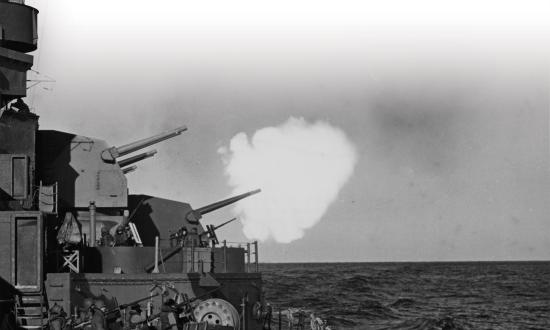Captain Rob Niewoehner, U.S. Navy (Retired)
The Falklands Campaign. With blockades, amphibious landings, and submarine warfare, it is all here. Most important, though, is the need for battlespace awareness. The whole affair balanced on a knife’s edge for want of carrier-based airborne early warning. However, that would have required carriers large enough for the E-2 Hawkeye. In the debate over future carriers’ size, the Royal Navy’s experience tells us, “big enough for E-2s.”
Mark Carlson, Military Writers Society of America
Close cooperation between air, surface, and undersea forces is the key to naval success. It is hard to find a perfect parallel in pre–World War II history, but the Cuxhaven raid of 1914 is a good example. The innovative cooperation of warships, seaplanes, submarines, and aerial reconnaissance allowed the Royal Navy to launch a raid on the Zeppelin sheds at Nordholz.
Michael Robkin
The Battle of the Aegates Islands, 241 BCE. Upstart Rome first copied naval superpower Carthage’s ship design, then further innovated, ridding their ships of superfluous multimission capabilities. Carthage’s fleet was underfunded, undertrained, and burdened with supplies and ground troops. Rome won, capturing Sicily, the first island chain in the Mediterranean.
David Lee Cornish
The strategic battle space the Russian and Japanese navies faced at the Battle of the Yellow Sea on 10 August 1904 is similar to what the U.S. Navy faces with the Chinese Navy today. Limiting the scale of conflict was preponderant to Japan’s success. Key to Japan’s limited war strategy was defining what constitutes victory—a question we are asking ourselves today.
Lieutenant Clay Huber, U.S. Navy
Lessons from the Battle of Jutland apply to the war we prepare for today. Friendly ships missed dated flag and lamp signals while the enemy intercepted, exploited, and fired on them. Centralized command stifled initiative, which prevented warships from engaging the enemy. Known poor-performing ordnance failed in the fight.
Don Chappell, U.S. Marine Corps Veteran
Through boldness and integrated special operations, Germany’s modern, outnumbered regional navy whipped the Royal Navy in its own backyard during a joint campaign stretching more than a 1,000 nautical miles during World War II’s Norwegian Campaign. The magnitude of the resulting strategic victory justified Germany’s loss of ten destroyers.
Lieutenant Commander Richard Kouyoumdjian Inglis, Chilean Navy Reserve
The naval Battle of Angamos on 8 October 1879 during the “War of the Pacific.” The Chilean fleet captured the Peruvian ironclad Huáscar, gaining command of the southeastern Pacific and the ability to take Chilean troops all the way to Peru and attack when and where it wanted.
William J. Prom, U.S. Marine Corps Veteran
The Battle of Tsushima in 1905 involved peer-strength rivals Russia and Japan fighting with modern warships and newly developed communications technology. The fleet of a local expanding empire decisively defeated the fleet of an older power that had to travel 18,000 miles to get there.
Colonel Mark Cancian, U.S. Marine Corps (Retired)
The Battle of the Java Sea from 27 February to 1 March 1942 pitted a combined Allied force, with centuries of naval heritage, against a slightly larger but dispersed adversary. However, weak command-and-control, new adversary technology (long-range torpedoes), and superior adversary reconnaissance produced a devastating defeat.
Commander Frank Klein, U.S. Navy (Retired)
The 1982 Falklands conflict. Antiaccess/area-denial, asset-intensive organic ASW, amphibious operations in the littoral, extended and vulnerable logistics, antiship cruise missile and nuclear/diesel attack submarine employment: The world saw all these aspects of modern naval warfare in this campaign.
Petty Officer Bradley Whetstone, U.S. Navy
The Battle of Manila Bay, which Theodore Roosevelt describe as a “splendid little war.” Later, on 16 December 1907, President Roosevelt would later order the Great White Fleet to globetrot 43,000 miles around the planet with 14,000 personnel, projecting America’s status as a world power, established during the 1898 Spanish-American War.
Captain Fred Furtek, U.S. Navy Reserve (Retired)
The entire British Navy Falklands Campaign. It was centered around the projection of power from the sea, naval air-to-air combat, surface-to-surface missile defense, a contested amphibious landing, and submarine warfare.
Major Hugh Vannoy Blanchard, U.S. Army (Retired)
Arguably the Battle of Tsushima in the Russo-Japanese War of 1905, which in type is not unlike 2020’s second battle of Nagorno-Karabakh. Both were relatively small wars in out-of-the-way places, but both pointed toward how future wars would be fought.
Lieutenant Commander Scott A. Wallace, U.S. Navy, Medical Corps
The United Kingdom’s response to the Falklands conflict is the best analogy to threats we face today in the Pacific first island chain. However, the analogy breaks down in that China is a superior or peer, while at the Falklands, the United Kingdom was slightly superior in capability.
Steven M. Crain
There is no doubt that the battle with the most far-reaching consequences was the Battle of Tsushima. It was the beginning of the end of Imperial Russia, and the beginning of a modern and militaristic Japan.
Carlisle Johnson
The Battle of Coral Sea for two reasons. It was essentially over the horizon and it secured Australia permanently as a friend and ally.
Dr. Thomas Stauffer
The Battle of Midway. It was the most consequential naval encounter in the most consequential war in human history. Given subsequent improvements in the technology of warfare, Midway’s importance likely will never be superseded.







